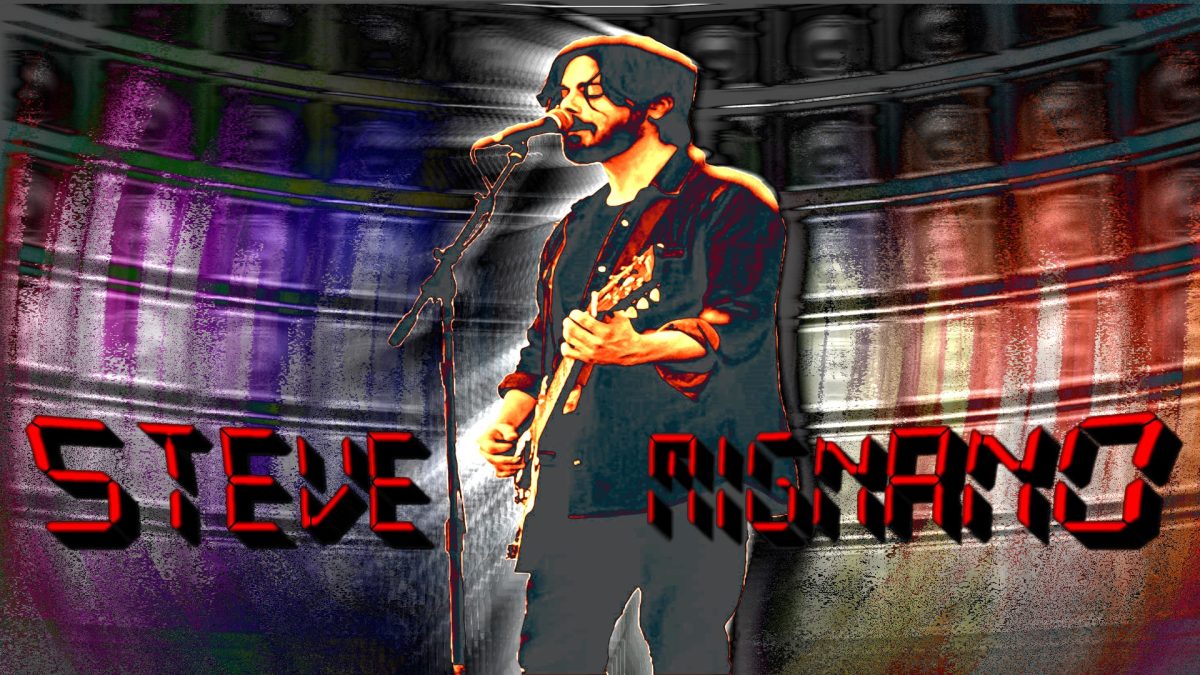Drab has rich soundscapes. There seems to be a thirst lately for bands with driving basslines whose guitars saturate the aural soundscape with lavish, soulful melodies. That may sound elementary, but the truth is that too many bands these days are trying to find the next direction with compositions that have shed elements of the tried and true. For me, Drab’s sound harkens back to an era when grunge rock was mighty. And music like I’m hearing from these guys was the tasteful counter to that movement that somehow found a way to compliment it simultaneously. It was anything but pop, super original, and slightly unpolished in its own right. A band like Drab is tipping its hat to this notion that there exists a space between extremes that does not lend itself to popularized conformity. In other words, you don’t have to commit yourself to either death metal or typified pop extremes to express a deviation from the norm. There’s a vein of rock that maintains an edge slightly left of center that is still respected by those that would normally find their comfort zone right in the middle. For his whole life, Steve Mignano has been able to move freely throughout these spectrums due to his lust for movement and change. And his ability to achieve accuracy amongst chaos affords listeners a guide through these waters. You can’t understand the plot if the acting sucks. And you can’t get a feel for a sound if it’s not in tune or on time. Now Garguts, Steve’s second project, pushes the division between what works and what doesn’t. They take the above notion of “unpolished” and kick it in the teeth. But again, Mr. Mignano embraces change here while feeling his way through at the top of his lungs. Because for this project, Steve isn’t holding a guitar. He’s strictly singing. Dylan Hemard (Green Gasoline) checks the axe for him, allowing him the freedom to roam. This band delivers the reassurance that can be sometimes felt in extremity. Because oddly enough, you can here a bit of Zeppelin in the beginning of their song Miller High Death. But then the kicking starts, giving listeners a bit of “oh yeah, I remember that” followed by “oh sh*t!” We will get into the line-up of this band later. But trust me, we’re all in for a wild ride with this one.
Originally, Steve is from Toledo, Ohio. His dad played guitar in bands and owned a guitar store in Westfield, Michigan. It always felt like guitar was his first language. But his eyes really lit up when he saw the movie Back to the Future. Seeing Marty McFly transform into a rock star at the high school dance struck a chord with seven-year-old Steve. Funny enough, he didn’t realize how deep that chord would carry at the time. But it was enough to get the ball rolling; well, that and countless air-guitar solos. His dad agreed to furnish him with lessons and Johnny B Good was the first. But unfortunately, a rambunctious Steve collided with a bit of attention deficit disorder and the guitar idea was soon shelved. By eleven, he returned though. And by fifteen, he had become serious, practicing daily. Being around his father and the musicians in his bands facilitated an accelerated learning rate. At this time, Youtube didn’t exist and real, human experiences still reigned. He would be at his father’s performances as a pre-teen and by the age of twelve, he was attending concerts. He recalls fondly being at shows for bands like Soundgarden and Megadeth. In a word, his sixteen-year-old self would say the Rage Against The Machine concert he saw at the Palace of Auburn Hills in Detroit was…. intense!!
There were three main radio stations where he grew up. Classic rock was on 104.7, Buzz 106.5 was an modern alt-rock station, and pop music played on 92.5. Classic and modern rock would escort him through his formative years. Bands like Led Zeppelin, AC/DC, Black Sabbath, Metallica, and Alice in Chains would not only influence him sonically, but furnish him with a sense of identity. Back then he also relied on tab books to further his music education. He would save up money to buy a book, learn the contents, then pass it around amongst friends. Nirvana’s In Utero, and Countdown to Extinction by Megadeth were a couple he remembers. He learned Nirvana, but he still struggles to this day with those Marty Friedman solos. There was also his parents’ album collection to help guide him down the neck of his path. He still has some of these records. His first love on vinyl was the blues master B.B. King. And he remembers how the haunting ballads like The Messiah Will Come Again and Sweet Dreams by Roy Buchanan sounded even creepier because that record had a slight warp to it. His father was into many styles of music. So, to appreciate different genres seemed natural to Steve. And this open mindset allowed him to see the similarities between the genres. While absorbing these sources; lessons, tab books, concerts, and records, Steve was playing in a garage band with friends. They would learn together, playing covers like Black Flag. One year, a band mate’s mom gifted him with studio time for his birthday. The band would record a two-song demo and instantly be famous in their own mind. The drum line at Steve’s high school would be his first experience performing publicly. They needed a guitar player for their rendition of Change of Seasons, by Dream Theater. He tuned his low E down to a low B so he could resemble the seven-string played originally in that song. Cranking up the amp and flexing his chops for a sizeable audience excited him so. He got to see the impact of loud guitar on his peers. Any fear quickly gave way to understanding within him. “It’s like when you’re standing in front of an abyss, and like there’s nowhere to go, you know, jump. And once you do it you begin to realize, oh well that’s not so bad. It’s not going to kill you. So, it gives you courage. It gives you more confidence. And you come back and you look at it. You can examine; oh I could do this better. This was awesome. This was my favorite part. Playing music is the most exhilarating thing in the world man. And um, it starts with a spark. But, you know, if you nurture that spark it grows into a fire. And, as I’ve gotten older, it hasn’t diminished at all man. It’s just gotten more complex. It’s like turning into this lotus flower of fire now”, Steve imparted.
He got good grades in school and was academically inclined naturally. But many of his friends in music would go onto vocational schools, leaving him a bit isolated. He resisted private school urgings from his parents, becoming more withdrawn and studying music during this time. He focused on listening to the elements contained within the music and began to think about what he wanted to do with his life. Music was the obvious vision. He also had an interest in film. He figured he could work in film while trying to launch a career in music. The day after he graduated high school, Steve packed all his stuff into his car and pointed the wheel toward Los Angeles. There was no plan in place or reason for that destination. But the town’s reputation for being a hot bed of cinema and ground zero for the recording industry was calling his name. This adventure, however, was short lived. He was in and out of bands while there. But he concedes his expectations were ridiculously high. And though he attended the Musician’s Institute for a semester, ultimately the cost of living would ground this flight. Steve would be back home in Ohio nursing his ego before he knew it. For the next three years, he worked in his father’s appliance parts warehouse. He would bring his guitar and practice every chance he could. Listening to records, transcribing solos, and trying to learn new chords kept the pilot lit for now. One day a friend reached out to him telling him about auditions happening nearby. The gig was with Johnny Reed, a Chicago style blues harp player. Steve was familiar with this artist through his dad’s record collection. The man’s stellar reputation made this proposition intimidating. But Steve muscled up the courage and went down to try out. He played two songs and was hired on the spot! For the next three years, Steve would tour the U.S. and Canada, playing counter to, and being coached by, Johnny. Though he had crawled many miles of paper in theory, nothing could prepare him for the techniques and methods involved in running with a band of this caliber. The experience would be the education. And he was cognizant enough to experience the revelation. He recalls, “I can’t remember exactly what festival we were at. But I remember it was on a large outdoor stage. And I remember listening to Johnny soloing. And what occurred to me is that he wasn’t just playing his harp. He was playing the whole stage. He was listening to the environment. He was listening to how his tone was coming through the speakers, how it was resonating. I remember being on stage with him and that occurring to me at that one moment. He was taking the environment and making it work. He was making adjustments on the fly to make sure his tone was cutting through.” Steve was coming to the realization that there was no one set of rules or standards for this. To show up at every performance, regardless of the venue, and play as you did at another time and location just wouldn’t have the same impact. What he witnessed was a musician making the stage resonate with his instrument. Through focused reflection, he’s been able to grasp these elements and affix them to his target as a professional musician.
After playing with Johhny Reed, Steve would move to Denver. And before long, he landed another gig playing with Cassie Taylor, a native of Boulder and daughter of well-known blues musician Otis Taylor. From 2010 to just before 2013, Steve toured the U.S., Europe, and Canada with Cassie’s band on her neo-soul release, Out Of My Mind. Getting this gig was different than how he got the Johnny Reed gig. With Reed, the slot was one that had been filled many times before. The style of music was rooted in traditions of a certain vein and the phrases were already mapped out. With Taylor, he was given songs that lacked his part. It was up to him to find what fit. He pulled from the many years he spent studying theory. Knowledge of the language allowed him to become versed in this variety. He also drew from his time studying technique. The books from his dad’s shop were filled with the rudiments of this and did not adhere to any particular genre. A book by Pat Martino taught him chord inversions and chord voicings. The CAGED system (author Bill Edwards, 1983) also expedited his progress. Once he learned those patterns it became easy to learn scales and chord voicings all over neck. Steve would use the literacy to express his newfound creative freedom with Cassie. And if you look, you’ll find what author Andy Ellis of Premier Guitar said about his work to be commendable. “In guitarist Steve Mignano, Taylor has a perfect foil. His long, searing bends and snarling riffs wrap around Taylor’s latte voice like a well-worn leather glove. Tone for days, deluxe dynamics, spirited delivery—Mignano has it all.”
While still touring with Cassie, Steve went on vacation to New Orleans and was struck by its indelible charm. He would ultimately move here on the conclusion of that tour. Absorbing the indigenous music and becoming a working musician in this environment satiated him. He was previously familiar with a reputation the city had amongst musicians. Of the territories surrounding this far-reaching microcosm, Steve says, “This is my favorite city in the world, man. I love everything about it. I love the food, love the people, love the music, love the atmosphere; everything. You know, I feel like it takes a particular kind of savage to live here. But I am that savage. I feel like it’s in my DNA in a way. Some of us belong here. And I feel like I belong here.” Together, with Casey Freitas on bass, Aaron Levy on drums, and Jacob Fitzmorris on guitar, Steve has formed Drab. They dropped a self-titled album in 2022. And their most recent single, Blacklight, is a dead reckoning for the grit between your toes. You know life put it there to disrupt you. But you begin to rub it around, and you come to like the sensation. Blacklight is evidence of the recent shift within the band’s sound. Casey Freitas was a newcomer on this imminent work. So, the inner mechanics of their line-up have changed as well. There is a new single on the way, Open Wound. But when this album drops, you’ll hear the movement toward a murkier, more malignant sound, doubling down on their freshman effort. With his second band, Garguts, Steve has set down the guitar to concentrate solely on testing the limits of his vocals. On indefinite hiatus, Green Gasoline’s Dylan Hemard (guitar) and Jon Castiex (drums) have aligned with Steve and Sterling Anderson (bass). Where Drab had become a comfortable grit, Garguts has created an annoyed flesh wound. Their sound penetrates while possessing the sensation of a rowdy garage band experiment. Rhythmic changeups, amp distortions, and effects quickly usher the listener into a chaotic bliss. This band will let our frustrations breathe. I do hope to see many of you tune into Steve’s podcast interview. As he and I discussed how these projects came about, how their first shows have been, and what the business end of these creations has taught him. And hearing him describe his experiences with Johnny Reed and Cassie Taylor was truly exhilarating. I thank you all so much for your continued interest.
Author: David Trahan



















